-
- PCB TYPE
- PRINTED CIRCUIT BOARD PROTOTYPE ALUMINUM PRINTED CIRCUIT BOARD R&F PCB FPC HIGH FREQUENCY PCB HIGH-TG PCB HEAVY COPPER PCB HDI PCB PCB FOR LIGHTING METAL CORE PCB
time:Jul 12. 2025, 15:47:37
In the rapidly evolving field of high-frequency and high-power electronics, the demand for advanced substrate materials has never been greater. Aluminum based copper clad laminates (CCLs) integrated with Rogers materials represent a cutting-edge solution, combining the thermal conductivity of aluminum with the superior electrical performance of Rogers' specialized dielectric materials. This article explores the technical synergy between these materials, their structural composition, design considerations, manufacturing processes, key applications, and emerging trends, highlighting their role in enabling next-generation electronic systems.
The Synergy of Aluminum Based CCL and Rogers Material
Defining the Composite Structure
Aluminum based CCL with Rogers material refers to a hybrid substrate where a conductive aluminum core is bonded to Rogers dielectric layers, which are further clad with copper foils. This structure leverages:
Aluminum Core: Provides exceptional thermal dissipation and mechanical rigidity, critical for managing heat in high-power components.
Rogers Dielectrics: Offers low dielectric loss, stable dielectric constant (Dk), and excellent signal integrity at high frequencies (above 1 GHz), properties essential for RF/microwave applications.
Copper Cladding: Enables efficient electrical conduction, supporting both power distribution and high-speed signal routing.
This combination addresses the dual challenges of thermal management and high-frequency performance, which are often conflicting in traditional substrates.
Key Performance Advantages
Thermal-Electrical Balance: Aluminum’s high thermal conductivity ensures heat from power amplifiers or RF transistors is rapidly dissipated, while Rogers dielectrics maintain low signal loss, even at elevated temperatures.
Mechanical Stability: The aluminum core resists warping under thermal cycling, a common issue in pure dielectric substrates, ensuring dimensional stability in harsh environments.
Design Flexibility: Rogers materials’ consistent Dk allows precise impedance control, while aluminum’s formability enables custom shapes for compact devices like automotive radar modules or 5G antennas.
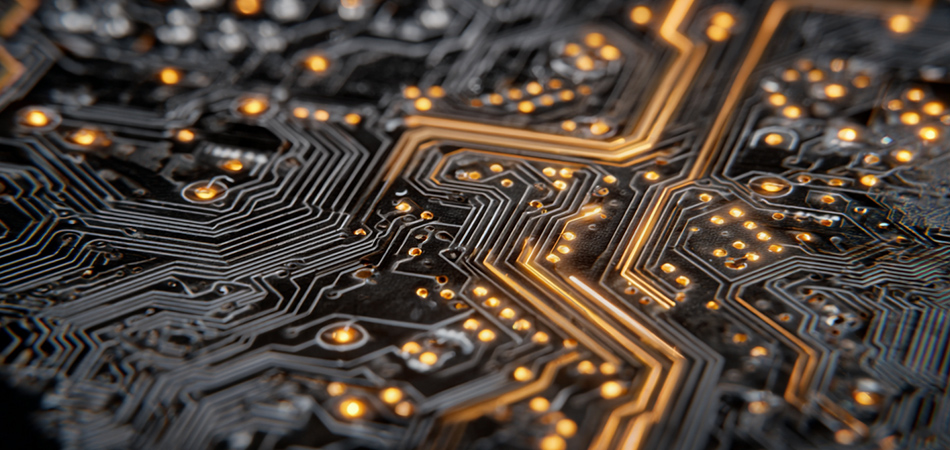
Material Properties of Rogers Dielectrics in Aluminum Based CCL
Rogers Dielectric Families for Hybrid Substrates
Rogers Corporation offers several dielectric materials optimized for integration with aluminum based CCLs:
PTFE-Based Materials: Known for ultra-low dielectric loss and stable Dk across frequency ranges, ideal for microwave and millimeter-wave applications (e.g., satellite communication).
Hydrocarbon Ceramic Composites: Balance cost and performance, offering good thermal conductivity and low loss, suitable for 5G base stations and IoT devices.
Liquid Crystal Polymer (LCP) Variants: Provide excellent dimensional stability and moisture resistance, making them suitable for high-reliability applications like aerospace avionics.
These materials are chosen based on the application’s frequency range, thermal demands, and mechanical requirements.
Aluminum Core Characteristics
The aluminum core in these CCLs is typically made from high-purity alloys, selected for:
Thermal Conductivity: Enables efficient heat transfer from active components to heat sinks or the ambient environment.
Corrosion Resistance: Natural oxide layer formation protects against environmental degradation, reducing the need for additional coatings in many applications.
Formability: Allows for thin gauges and complex geometries, supporting miniaturization in portable electronics and wearables.
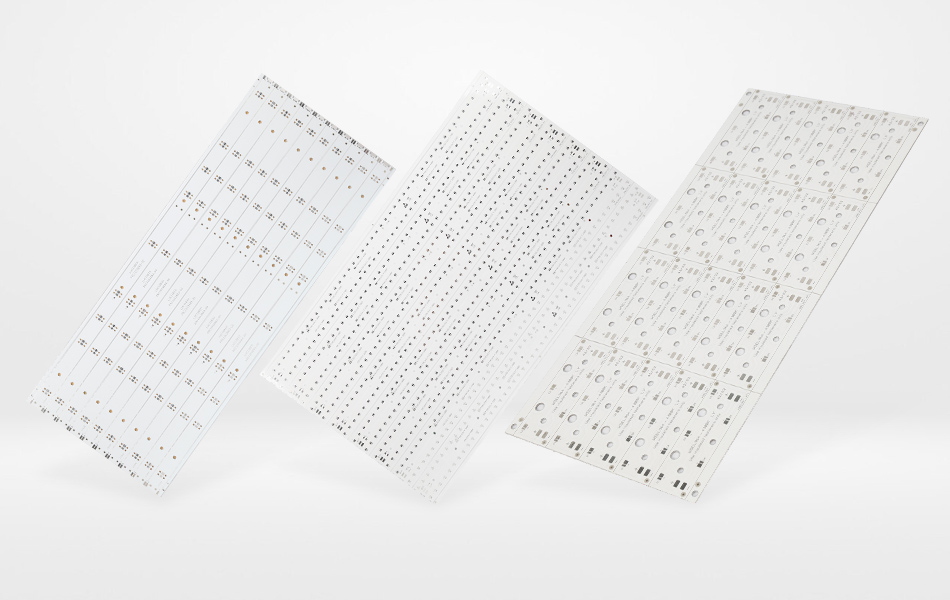
Design Considerations for High-Performance Applications
Impedance Control and Signal Integrity
In high-frequency designs, maintaining controlled impedance is critical to prevent signal reflection and loss. Key strategies include:
Dielectric Thickness Optimization: Rogers materials’ consistent Dk allows precise calculation of trace width and dielectric thickness to achieve target impedance (e.g., 50Ω for RF lines).
Ground Plane Design: The aluminum core can function as a solid ground plane, reducing electromagnetic interference (EMI) and providing a low-impedance return path for high-speed signals.
Trace Routing: Avoiding sharp bends and minimizing trace length reduces signal distortion, especially in millimeter-wave applications where wavelength is short.
Thermal Management Integration
The aluminum core’s thermal properties are maximized through design techniques:
Thermal Vias: Placed near heat-generating components (e.g., power amplifiers) to create direct pathways from the copper layer to the aluminum core, accelerating heat dissipation.
Heat Sink Compatibility: The aluminum surface can be directly bonded to external heat sinks using thermal interface materials, enhancing convective cooling in high-power scenarios.
Mechanical and Environmental Resilience
Thermal Cycling Resistance: The mismatch in coefficients of thermal expansion (CTE) between aluminum and Rogers materials is managed through careful lamination processes, reducing stress on solder joints during temperature fluctuations.
Moisture and Chemical Protection: Rogers dielectrics inherently resist moisture absorption, while the aluminum core’s oxide layer provides corrosion resistance, making the substrate suitable for outdoor or industrial environments.
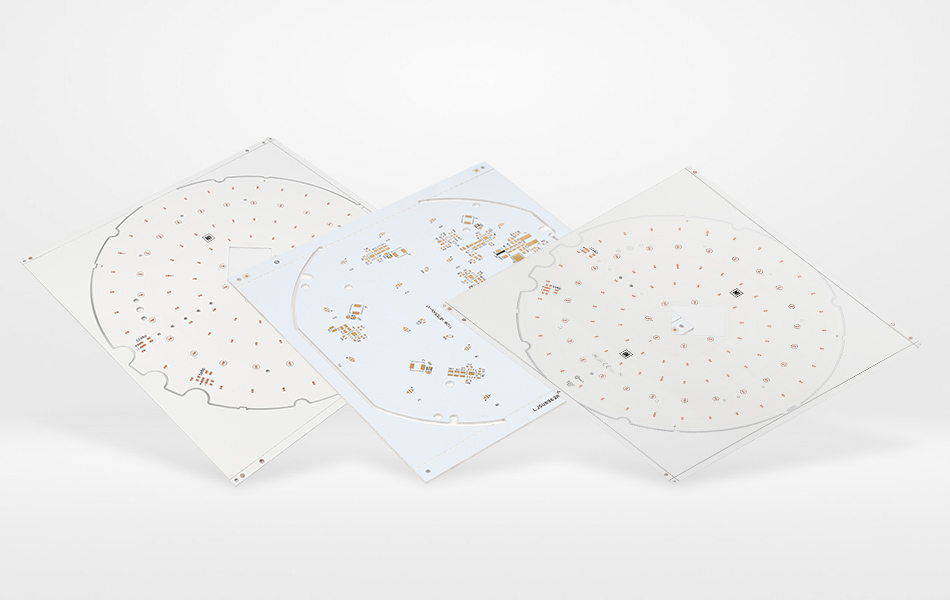
Manufacturing Processes for Aluminum Based CCL with Rogers Material
Substrate Preparation
Aluminum Surface Treatment: The aluminum core undergoes degreasing and micro-etching to enhance adhesion with Rogers dielectric layers. This step ensures a void-free bond critical for thermal and electrical performance.
Rogers Material Cutting: Rogers dielectrics are precision-cut to match the aluminum core dimensions using laser or waterjet cutting, minimizing material waste and ensuring tight tolerances.
Lamination
The bonding of aluminum, Rogers dielectrics, and copper foils is a critical process:
Controlled Pressure and Temperature: Lamination is performed in vacuum presses to eliminate air bubbles, with parameters tailored to Rogers material specifications (e.g., PTFE-based materials require higher temperatures than hydrocarbon composites).
Adhesive Selection: For some Rogers materials, specialized adhesives with low dielectric loss are used to bond layers, ensuring minimal signal attenuation at high frequencies.
Copper Cladding and Circuit Formation
Copper Foil Lamination: Thin copper foils (electrolytic or rolled) are bonded to the Rogers dielectric surface, providing the conductive layer for circuit traces.
Photolithography and Etching: Circuit patterns are transferred using laser direct imaging (LDI) for high precision, followed by chemical etching to remove unwanted copper, forming signal and power traces with tight dimensional control.
Quality Validation
Dielectric Constant Testing: Impedance analyzers verify that Rogers materials maintain their specified Dk after lamination, ensuring signal integrity.
Thermal Conductivity Measurement: Methods like the laser flash technique assess heat transfer efficiency across the aluminum-Rogers interface.
Mechanical Testing: Peel strength tests validate the bond between layers, ensuring durability under mechanical stress.
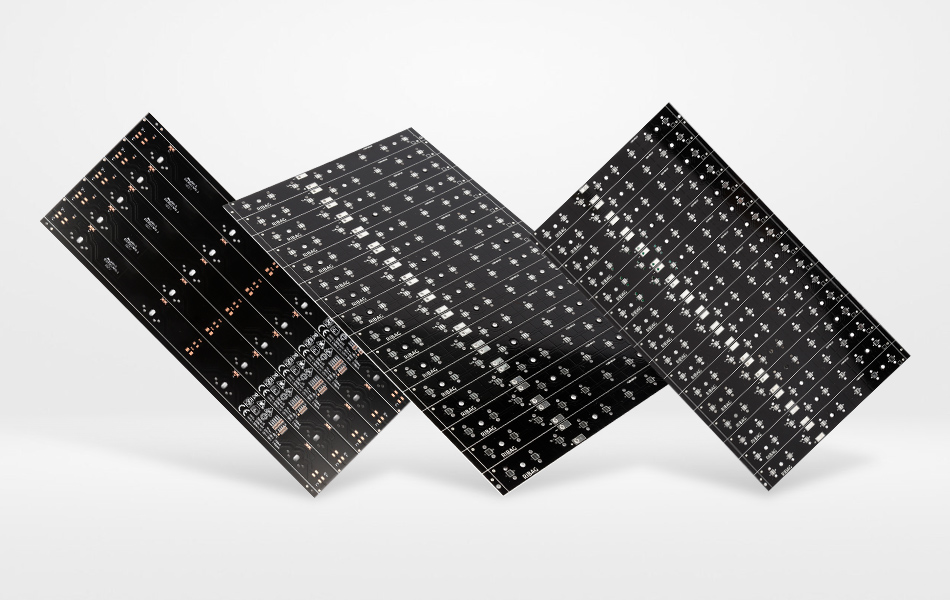
Applications of Aluminum Based CCL with Rogers Material
5G and Wireless Communication
Base Station Antennas: The combination of low loss (from Rogers) and thermal management (from aluminum) enables high-power RF amplifiers and phased array antennas, critical for 5G’s mmWave bands.
Small Cell Transceivers: Compact designs benefit from aluminum’s mechanical strength and Rogers’ high-frequency performance, supporting dense urban 5G deployment.
Aerospace and Defense
Radar Systems: Airborne and ground-based radar modules use these substrates for their ability to handle high-power transmitters while maintaining signal integrity in the 10–100 GHz range.
Avionics Communication: Satellite communication terminals rely on the substrate’s stability under extreme temperatures and low signal loss for reliable data transmission.
Automotive Electronics
ADAS Radar: 77 GHz automotive radar systems require Rogers’ low loss for precise object detection, while aluminum’s thermal conductivity manages heat from high-power chips in tight engine bay enclosures.
Vehicle-to-Everything (V2X) Communication: Enables reliable high-frequency data exchange between vehicles and infrastructure, supported by the substrate’s EMI resistance.
Industrial and Medical Devices
Industrial Sensors: High-frequency sensors for non-destructive testing use the substrate to maintain signal integrity while withstanding harsh factory environments.
Medical Imaging: MRI and ultrasound equipment benefit from low dielectric loss in Rogers materials, ensuring accurate signal processing, while aluminum’s thermal management prevents overheating in compact devices.
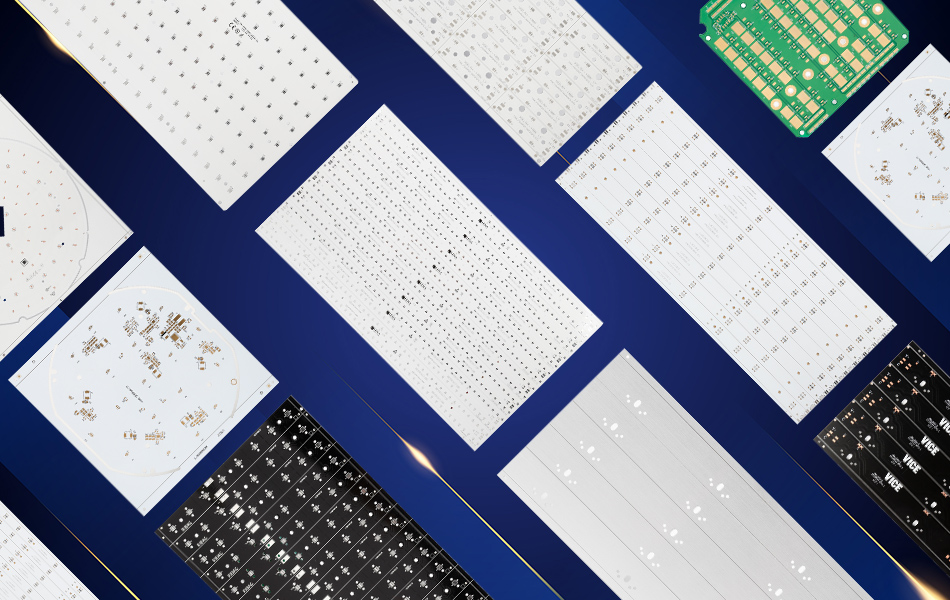
Emerging Trends and Future Developments
Miniaturization and High-Density Integration
Advancements in laser drilling and microvia technology are enabling smaller, more complex circuits on these substrates. This supports the development of compact 5G modules and wearable RF devices, where space is at a premium.
Sustainable Manufacturing
Recyclable Materials: Efforts to incorporate recycled aluminum into cores and eco-friendly Rogers dielectric variants (e.g., bio-based hydrocarbons) are reducing environmental impact.
Energy-Efficient Processes: Low-temperature lamination techniques are being developed to reduce energy consumption during manufacturing, aligning with global sustainability goals.
Extended Frequency Range Support
As wireless technologies push into higher frequency bands (e.g., 6G’s terahertz range), Rogers materials are evolving to maintain low loss, while aluminum cores are being optimized for even better thermal conductivity to handle increased power densities.
Integration with Active Components
Research is underway to embed active devices (e.g., diodes, transistors) directly into the aluminum-Rogers substrate, creating system-in-package (SiP) solutions that reduce size and improve signal integrity in high-frequency systems.
Conclusion
Aluminum based CCL with Rogers material represents a pivotal innovation in high-performance electronics, merging the thermal robustness of aluminum with the electrical excellence of Rogers dielectrics. This hybrid substrate is uniquely positioned to address the demands of 5G, automotive radar, aerospace, and other advanced applications, where high frequency, power efficiency, and reliability are critical. As technology continues to advance, the collaboration between these materials will drive further breakthroughs in miniaturization, sustainability, and performance, solidifying their role as a cornerstone of next-generation electronic design. For engineers and manufacturers, understanding and leveraging this synergy is key to unlocking the full potential of tomorrow’s high-speed, high-power systems.

Got project ready to assembly? Contact us: info@apollopcb.com



We're not around but we still want to hear from you! Leave us a note:

Leave Message to APOLLOPCB
